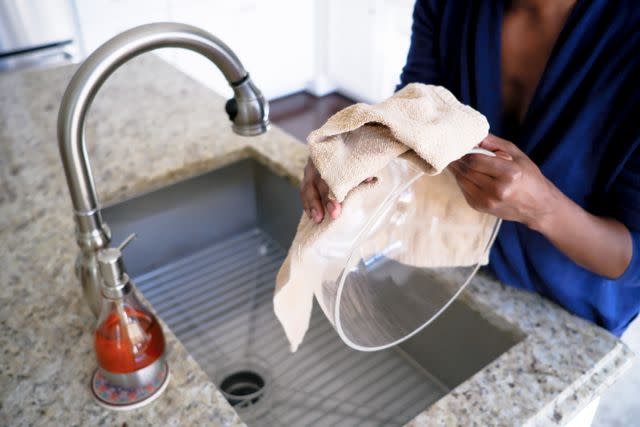Should You Towel-Dry Dishes? Here's What the Experts Have to Say
Plus, the best ways to get dishes dry when time and countertop real estate are of the essence.
Finding the right method for drying dishes isn’t one size fits all. It can come down to a variety of factors, most of which hinge on time and space, two scarce resources in many homes. “Most of us probably let convenience guide our dish-drying habits, but there’s one more factor to consider: the cleanliness of our chosen technique,” says Myhanh Truong, senior specialist application engineer at 3M Home Care, Auto, and Workspace.
A dishwasher can be a safe and effective way to avoid bacteria and germ transfer when drying dishes, particularly if used on the sanitize cycle. “Per the National Sanitation Foundation, dishwashers are required to heat water to a minimum of 150°F (although some dishwashers may go above that),” says Bree Lemmen, Whirlpool kitchen brand manager. “A sanitize cycle will typically increase the heat during the main wash and finish with an even hotter final rinse.” But if there’s lingering water on the tops of your upside-down cups, dishware crevices, and more, finding an alternate drying method might still be key.
Here, Truong and Lemmen share more tips for avoiding germs while still getting dishes dry.

Getty Images / Grace Cary
The Best Way to Dry Dishes
We all know that the goal of drying dishes is to remove water, but just how to achieve optimal results is the real question. According to Truong, the best way to go about it, both from a hygiene and practicality standpoint, is to air dry. “Once the dishes are washed and on a drying rack, you let nature and gravity take its course,” she explains. “This is usually done using a sink-side drying rack.”
Related: The 13 Best Dish Drying Racks of 2023 for Your Kitchen
But there are times when air-drying just won’t cut it—whether from a time standpoint or if you need to get dishes out of the way sooner rather than later when company is coming. For that reason, she and Lemmen suggest two alternatives. Just make sure you follow their tips to decrease the likelihood of bacteria transfer.
The Best Way to Dry Dishes Using a Cloth
While it can be safe to use a towel to dry dishes, there are certain factors to keep in mind, particularly when it comes to material selection and the cleanliness of the towel. “Microfiber cloth is regarded as the best material for dish towels,” says Truong. “If dishes are wet and you don't have time to let them air dry, wipe them off with a fresh microfiber cloth before you put them away.”
Avoid stacking plates or dishes when wet, as Truong says this is a surefire way to proliferate bacteria. “If you must use a dish towel for items that can’t air-dry, try to wash the towels as often as possible, ideally using a clean towel every day,” says Truong. “Also, let it dry between uses.”
Using a dishcloth that is wet or soiled could reintroduce bacteria and other impurities, while even clean non-microfiber cloths could leave behind fibers and potentially other elements that you probably don’t want lurking on your dishware.
The Best Way to Dry Dishes in the Dishwasher
Things can get a little complicated when it comes to determining the best way to dry dishes using the dishwasher. “While the Heat Dry cycle is typically the preferred method, the same cycle should not be used for each type of load,” explains Lemmen. “For example, the sanitize cycle is great for tough loads and occasional deep cleaning, but not necessary for everyday washes due to the extra time, energy, and water it uses.”
Once you determine the right mode for your needs, Lemmen provides a few more tips for making the most out of your dishwasher's dry cycle.
Use a rinse aid. While it might seem like a separate objective, a rinse aid can help dry plastic items that can be trickier to fully dry thanks to their lower thermal conductivity.
Opt for the Extended Heat Dry or Heat Dry options if you want to ensure dishes are fully dry.
Always unload from the bottom up in order to keep any leftover water on the top racks from falling onto the clean dishes in the lower racks.
Dish-Drying Methods to Avoid
“Air-drying dishes or using a microfiber cloth is simply a matter of the available space on the dish rack,” says Truong. So if time or space doesn’t allow, you might find yourself needing to dry dishes by hand or loading them into the dishwasher in a pinch. In that case, there are certain factors to avoid, most notably, paper towels.
As Truong explains, using paper towels would be a wasteful option, particularly if you have a cabinet’s-worth of dishes to make it through. Although opting for the dishwasher can be both effective and reliable if following the manufacturer’s best practices, it can potentially result in less-than-ideal results like using plenty of energy while still sometimes leaving dishes wet.
In order to make the most of your drying method, whatever it may be, follow Truong and Lemmen’s advice and you should set yourself up for a more successful (and bacteria-free) dish duty.
For more Better Homes & Gardens news, make sure to sign up for our newsletter!
Read the original article on Better Homes & Gardens.

